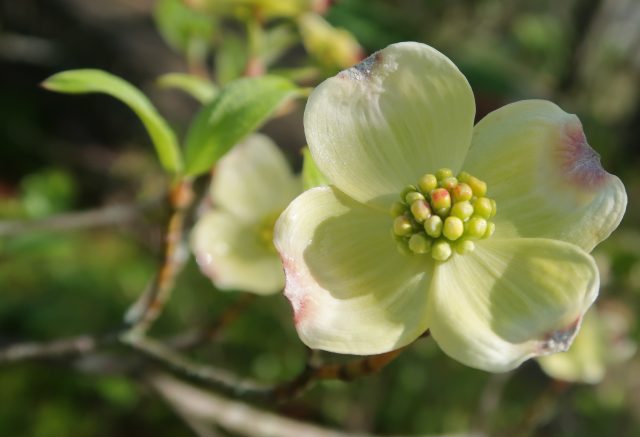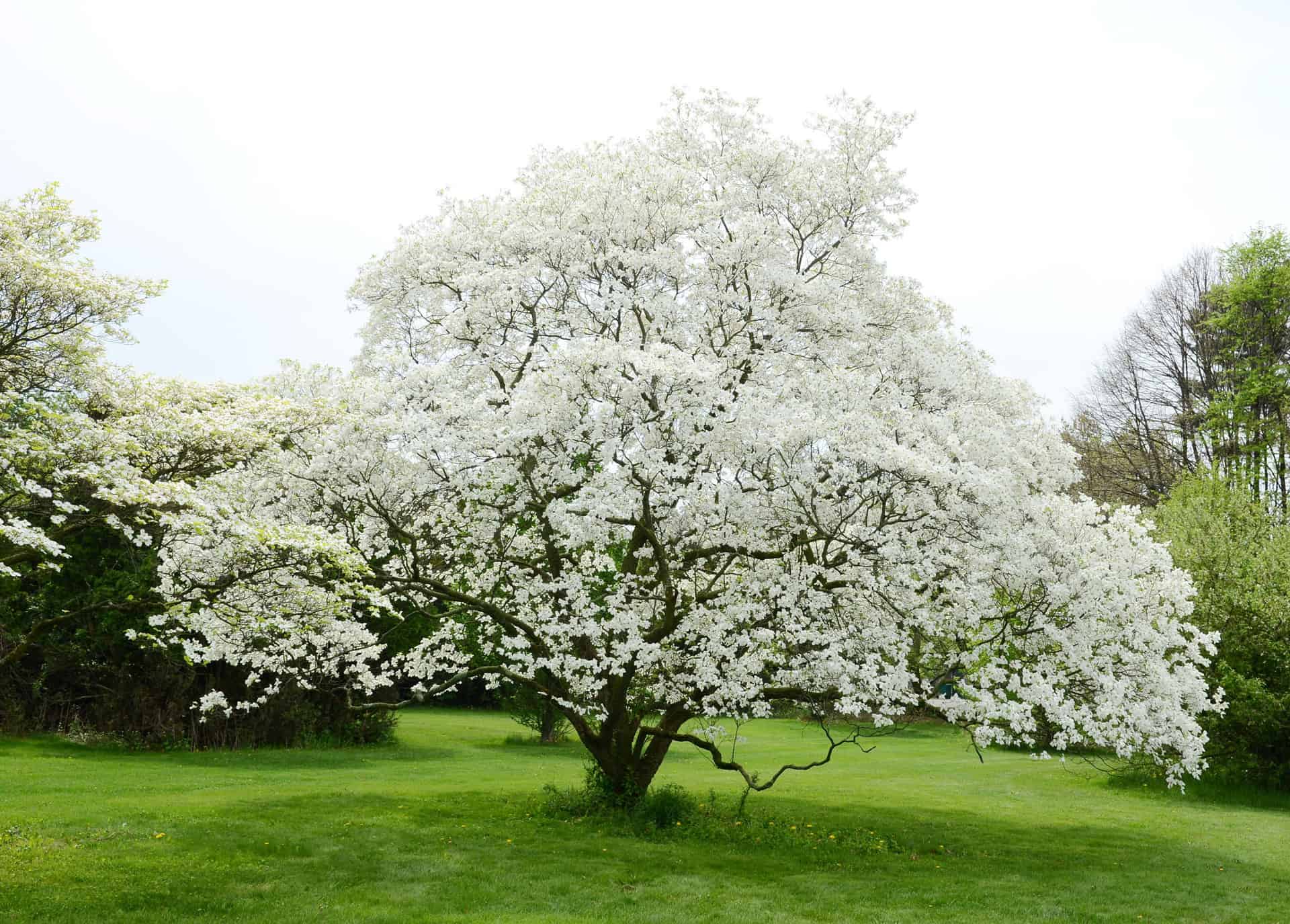Dogwood trees with their showy spring flowers and attractive branching structure make a stunning focal point in any garden. To complement their beauty, consider combining dogwoods with these ideal companion plants.
Groundcovers
Groundcovers spread to form a lush carpet under the dogwood’s canopy. Try:
- Ferns – Evergreen ferns like Christmas fern or deciduous varieties like ostrich fern provide lovely texture.
- Hostas – The wide selection of leaf shapes, sizes, and variegation patterns complement dogwoods.
- Euonymus – Evergreen euonymus groundcovers like ‘Emerald Gaiety’ brighten shady sites
- Carex – Sedges like C. morrowii or C. oshimensis offer grassy texture.
- Epimediums – Low-growing perennials with delicate flowers and heart-shaped foliage
Flowering Perennials
Perennials add pops of color and attract pollinators. Consider:
- Azaleas – Early spring blooms like native azaleas coincide with dogwood flowers.
- Astilbes – Feathery plumes come in white, pinks, reds, and purples for summer interest.
- Hellebores – Blooms late winter to early spring before dogwoods, some types stay evergreen.
- Heucheras – Coral bells offer myriad leaf colors like burgundy, chartreuse, silver, and purple.
- Ferns – Along with their lovely forms, some offer bright colors like Japanese painted fern.
Shrubs
Shrubs share the shade preference of dogwoods. Good choices include:
- Hydrangeas – Bigleaf, panicle, and oakleaf hydrangeas provide summer blooms.
- Rhododendrons – Evergreen leaves and spring blooms enhance dogwoods.
- Viburnums – Plants like arrowwood viburnum offer spring flowers and fall berries.
- Holly – Evergreen hollies or deciduous inkberry brighten the area when dogwoods are bare.
With thoughtful plant pairings, you can create an eye-catching garden that looks terrific year round anchored by the always captivating dogwood.
Choose the Best Site & Adopt the Best Practices
North American dogwood trees (C. florida) are understory plants and are happiest growing beneath larger canopy trees. They perform best when growing in a partially shady spot with filtered, dappled light. Cornus kousa blooms more prolifically in full sun but will tolerate shade. Required sun exposure often depends on the site’s climate. A Cornus florida tree may be able to withstand more sun in a milder versus a warmer climate.
Both species need well drained soils and cannot withstand wet feet. Soil that is high in acidic organic matter is helpful because it acts as mulch and keeps roots cool while giving them the best nutrition possible. Test the pH of your soil to determine the acidity. If an increase in acidity is needed, simply apply a solution marketed for hollies and rhododendrons. Keep in mind that too much nitrogen can inhibit flower production. And never fertilize a young tree during its first year in the ground. It will be too sensitive while adjusting to its new home. Dogwoods do not tolerate extremes well. Intense heat, drought, and cold will increase the tree’s predisposition to disease and insect attacks. [/vc_column_text][/vc_column][vc_column width=”1/2″].

Tips for Growing Happy Dogwood Trees
Publish Date: 4/15/21
About 40 species and many cultivars of deciduous trees and shrubs, mostly from north temperate climates, are in the genus Cornus, which includes dogwoods. Dogwoods are grown for their showy flowers, colorful bark, and their architectural, nearly horizontal branching pattern. The flowers are very small, and there are bigger bracts around them that range in color from light pink to dark pink. Bracts look like petals, but they are actually modified leaves.
The Carell Dogwood Garden at Cheekwood is the centerpiece of our Nationally Accredited Cornus Collection®. By April 1, every year, the dogwoods at Cheekwood make everyone who visits the 55-acre estate very happy. The first group of North American and Asian species was given to and planted in the Carell Dogwood Garden in 1982. The garden is named after the kind family who gave the collection. As the number of these woodland trees increased, so did their territory. Today, there is not a garden at Cheekwood without at least one dogwood to offer. The botanical garden keeps the dogwood collection in the best shape possible. In 2012, the Plant Collections Network of the American Public Garden Association recognized and accredited the collection. The garden staff at Cheekwood used the tips in the next few paragraphs to help you take better care of the dogwood trees and shrubs in your collection. [/vc_column_text][/vc_column][vc_column width=”1/2″].

The first and most important thing to do to grow a beautiful dogwood is to start with good, healthy material. Fully inspect your tree candidates from limbs to root flares, ensuring there is no scarring on the trunk. This scarring could be a sign of freeze crack. The vascular system could be damaged, and the tree will have trouble taking in both water and food if this happens. Check the crown for full healthy branches. If you see a lot of dead branches, keep on moving. Do the leaves look good? If many of the leaves have spots, blotches, or holes in them, there may be a disease or pest problem. Does the tree look healthy and have a strong central truck? Is it standing tall and straight? If possible, try to avoid trees with two trunks. Also, watch out for any wires or strings that are squeezing the tree, like on a ball and burlap tree. These should both be loose enough to slip your finger underneath. Check out the roots if you are able. Avoid trees that are girdled by roots that circle the trunk at soil level.
Thanks to the ground-breaking work Dr. Elwin Orton started many years ago at Rutgers University. You can find many types of dogwoods at your local garden center that are resistant to disease and insects. These cultivars are hybrids made between our native dogwood (C. florida), Pacific dogwood (C. nuttallii) and the Asian species, C. kousa. Woody plants expert, Dr. Michael Dirr rates Aurora®, Celestial™, and Constellation® as the best of the original Rutgers hybrids. [/vc_column_text][/vc_column][vc_column width=”1/2″].

Fertilizer For Dogwood Trees – Speedy Growth
FAQ
Do coffee grounds help dogwood trees?
How to encourage dogwoods to bloom?
What month is best to plant a dogwood tree?
Can you plant hostas under dogwood trees?
What plants should I put under my dogwood tree?
Choosing plants to put under your dogwood tree is crucial. You have to select those thriving in your dogwood tree’s exact conditions. You can plant shrubs, landscape plants, spring-bloom perennials, and summer-blooming perennials to be a companion to your precious dogwood tree. If you want to know the specifics, we suggest you keep reading.
Are companion plants good for Dogwood?
Companion plants also act as guardians, protecting your dogwood from unwanted intruders. Some plants naturally repel harmful pests, acting as a barrier of defense for your beloved tree. It’s like having loyal bodyguards who keep potential threats at bay, leaving your dogwood to bask in tranquility. What about soil improvement?
How to choose a dogwood tree?
Understand the specific needs of your dogwood tree and choose companions that can thrive in the same conditions. By meeting your dogwood’s needs, you create a harmonious environment where everyone can flourish. Your garden is like a grand tapestry, and each plant plays a crucial role in the overall composition.
What shrubs grow well with dogwood?
Many shrubs make good companions for Dogwood. All Dogwoods like to grow in slightly acidic soil and will perform best alongside other shrubs that like a lower pH soil. Snowberry, Mahonia, Rhododendron, and other broadleaf evergreens are good choices for moderate climates such as those in USDA zones 5-8.
- A Complete Guide to Caring for Yuki Cherry Blossom Shrub - January 23, 2025
- Identifying Red Hot Poker Seeds: What to Look For When Harvesting Torch Lily Pods - January 23, 2025
- A Complete Guide to Harvesting Evening Primrose Seeds - January 23, 2025

